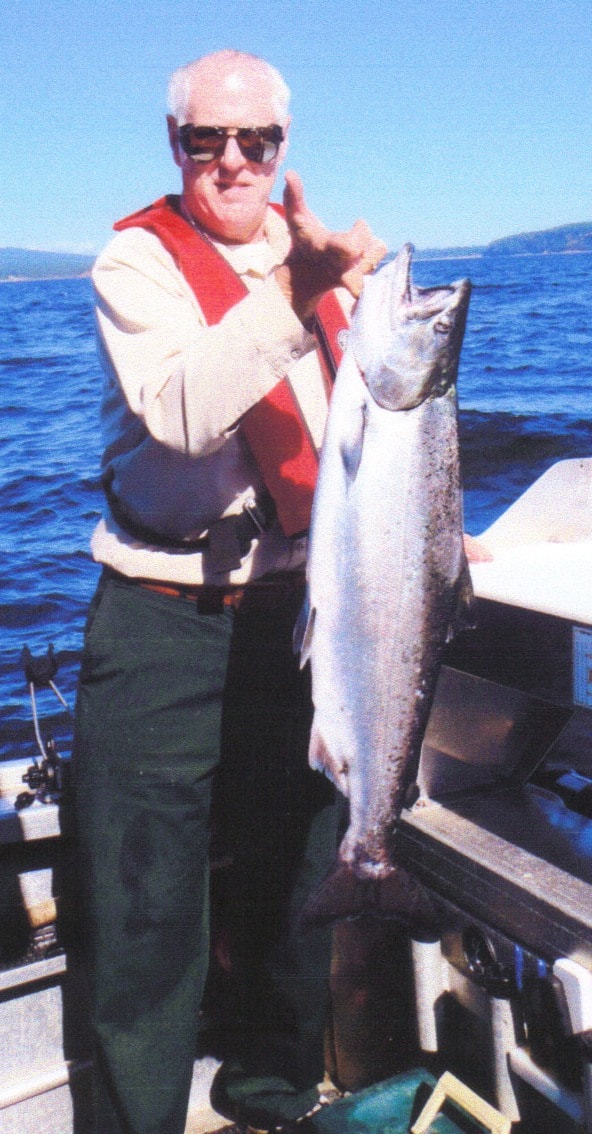In the broad sense of migrations and travel routes, the Strait of Georgia is an important highway for many species of salmon. However for the majority of local anglers it is the chinook salmon that travel the mysterious highway currents of the strait that attract the most attention.
For the past month one of the most important stopovers for chinook has been The Hump at Kitty Coleman. I know of one evening catch of seven chinook by four local anglers – that is good fishing.
Several fish have been weighed in at over 30 pounds. These are migrating stocks headed for any of the multitude of rivers that drain into the Strait and other waters in Washington. They do not stay long in our waters, but when they stop for feeding breaks they produce some excellent fishing if you are present during their feeding forways.
Fish have been taken throughout the day – but the evenings have been especially productive. During the evening do not hesitate to fish the inside waters from Kitty Coleman to Seal Bay because the salmon follow the bait toward shore as it moves into shallow water to feed.
For this holiday weekend there should be some good bites at low-water slacks during the midday and evening bites on the high-water slacks.
The 200-foot shoals north of Little River and the Powell River ferry lane can be productive if you see bait on your sounder. Cape Lazo should be good for passing fish and also for fall chinook headed for the Puntledge.
The 60- to 100-foot waters from the Bell Buoy to below Palliser Rock can be an important staging area for in-bound fall chinook to the Puntledge and should be good for the rest of September. If you are fishing this area and notice seagulls actively feeding on the shallow waters of the shoals it is an opportune time to do some jig fishing with Buzz Bombs and other drift lures because there is a good possibility of feeding chinook and coho in the schools of baitfish.
If you are an avid troller, the whole east side of Hornby Island off the 160- to 200-foot depth is an important travel route for migrating chinook and coho. Again, if you see active seagulls (especially small Franklins) workings schools of bait near inshore waters of 30 to 60 feet there is more often than not salmon feeding in the same schools. Try jigging.
The 140- to 200-foot waters off Flora should be productive, but be careful because these rocky shoals are hard on downrigger balls. The waters off Tribune Bay have held good quantities of bait most of the summer and should not be overlooked for coho, feeder and home-bound Qualicum chinook. The shoals off the Qualicum Rivers should be producing chinook this weekend.
Beach fishing for pinks and coho continues and should produce excellent results at the various stream shorelines from Oyster Bay to Nile Creek. Early morning high slacks are good times to be on the beaches because the fish should be near the shore.
Lingcod season and rockfish in our waters will close at the end of September. The midday low tides are good times to target lings on rocky outcrops in depths from 30 to 200 feet; bait and suitable jigs work. Remember rockfish do not survive catch-and-release very well so it makes sense to avoid them if possible after you have kept your one fish limit.
Halibut – Yes we have some in local waters. I received the following variation order number 2012-328: "Recreational fishing for halibut under the B.C. tidal water license will close effective 23:59 hours Sept. 9 for the balance of the year." This variation order covers all coastal waters in British Columbia.
Shellfish – Last week Chuck Ashcroft and I were travelling up Baynes Sound when we found ourselves in huge blooms of red tide. The water was like a sea of blood in many places. This is dangerous stuff. I would not recommend any gathering of oysters and clams until we get an all-clear from DFO.
Labour Day weekend is the last long weekend prior to school opening and may be a good opportunity to start some child on a lifelong career of recreational fishing. So far, mine has spanned eight decades and many tall tales.
Ralph Shaw is a master fly fisherman who was awarded the Order of Canada in 1984 for his conservation efforts. In 20 years of writing a column in the Comox Valley Record it has won several awards.
